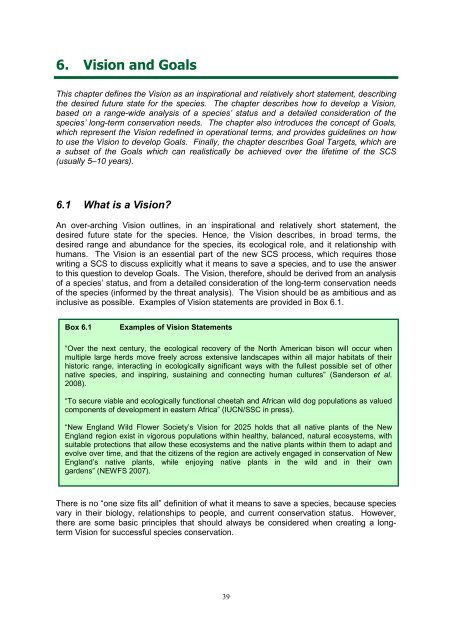Strategic Planning for Species Conservation: A Handbook - IUCN
Strategic Planning for Species Conservation: A Handbook - IUCN
Strategic Planning for Species Conservation: A Handbook - IUCN
You also want an ePaper? Increase the reach of your titles
YUMPU automatically turns print PDFs into web optimized ePapers that Google loves.
6. Vision and Goals<br />
This chapter defines the Vision as an inspirational and relatively short statement, describing<br />
the desired future state <strong>for</strong> the species. The chapter describes how to develop a Vision,<br />
based on a range-wide analysis of a species’ status and a detailed consideration of the<br />
species’ long-term conservation needs. The chapter also introduces the concept of Goals,<br />
which represent the Vision redefined in operational terms, and provides guidelines on how<br />
to use the Vision to develop Goals. Finally, the chapter describes Goal Targets, which are<br />
a subset of the Goals which can realistically be achieved over the lifetime of the SCS<br />
(usually 5–10 years).<br />
6.1 What is a Vision?<br />
An over-arching Vision outlines, in an inspirational and relatively short statement, the<br />
desired future state <strong>for</strong> the species. Hence, the Vision describes, in broad terms, the<br />
desired range and abundance <strong>for</strong> the species, its ecological role, and it relationship with<br />
humans. The Vision is an essential part of the new SCS process, which requires those<br />
writing a SCS to discuss explicitly what it means to save a species, and to use the answer<br />
to this question to develop Goals. The Vision, there<strong>for</strong>e, should be derived from an analysis<br />
of a species’ status, and from a detailed consideration of the long-term conservation needs<br />
of the species (in<strong>for</strong>med by the threat analysis). The Vision should be as ambitious and as<br />
inclusive as possible. Examples of Vision statements are provided in Box 6.1.<br />
Box 6.1 Examples of Vision Statements<br />
“Over the next century, the ecological recovery of the North American bison will occur when<br />
multiple large herds move freely across extensive landscapes within all major habitats of their<br />
historic range, interacting in ecologically significant ways with the fullest possible set of other<br />
native species, and inspiring, sustaining and connecting human cultures” (Sanderson et al.<br />
2008).<br />
“To secure viable and ecologically functional cheetah and African wild dog populations as valued<br />
components of development in eastern Africa” (<strong>IUCN</strong>/SSC in press).<br />
“New England Wild Flower Society’s Vision <strong>for</strong> 2025 holds that all native plants of the New<br />
England region exist in vigorous populations within healthy, balanced, natural ecosystems, with<br />
suitable protections that allow these ecosystems and the native plants within them to adapt and<br />
evolve over time, and that the citizens of the region are actively engaged in conservation of New<br />
England’s native plants, while enjoying native plants in the wild and in their own<br />
gardens” (NEWFS 2007).<br />
There is no “one size fits all” definition of what it means to save a species, because species<br />
vary in their biology, relationships to people, and current conservation status. However,<br />
there are some basic principles that should always be considered when creating a longterm<br />
Vision <strong>for</strong> successful species conservation.<br />
39

















